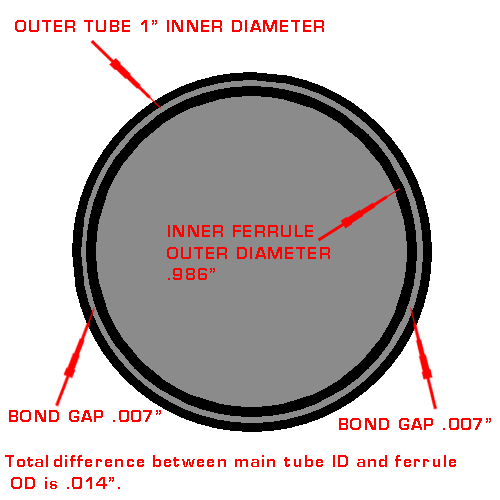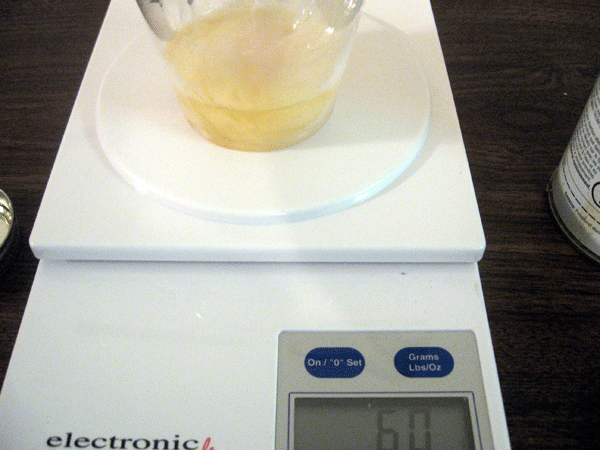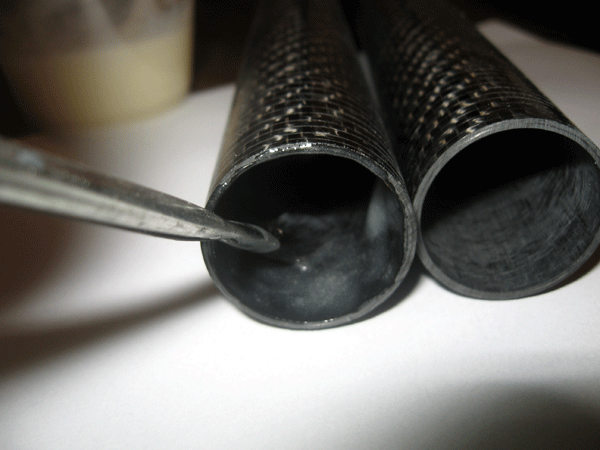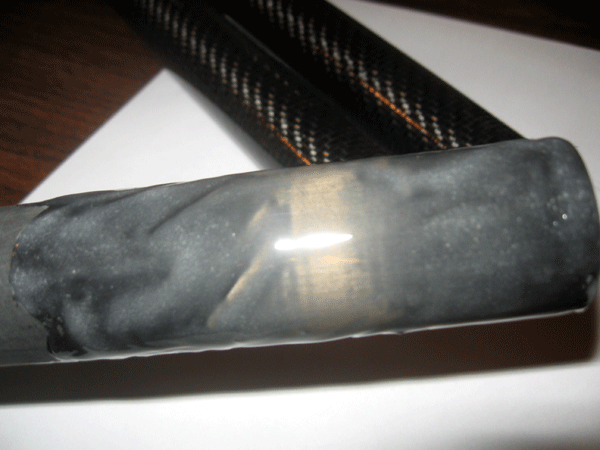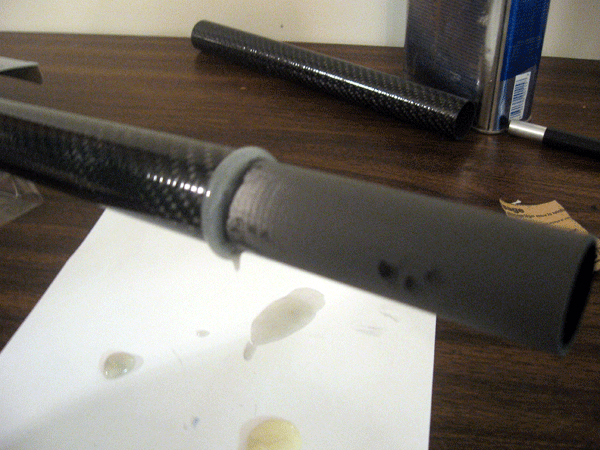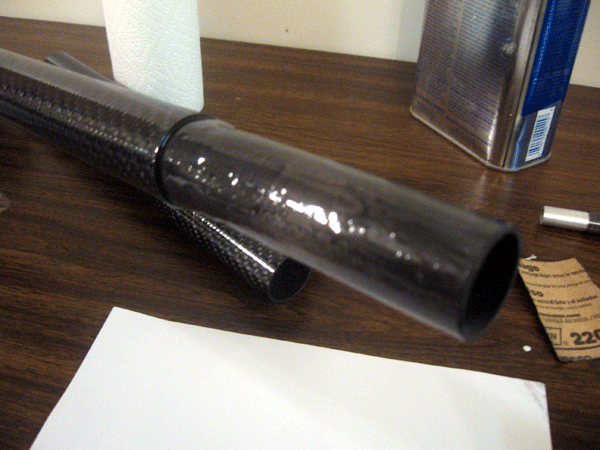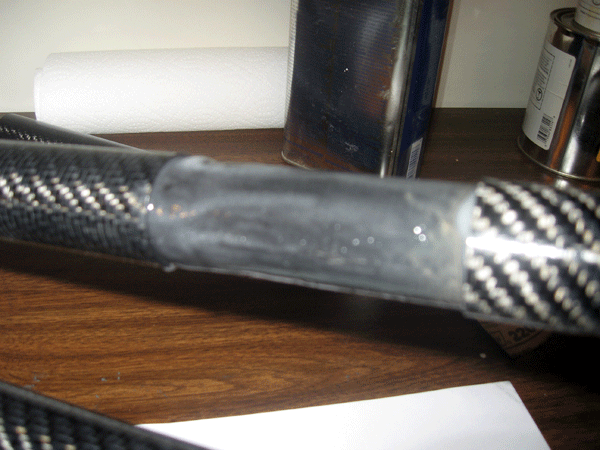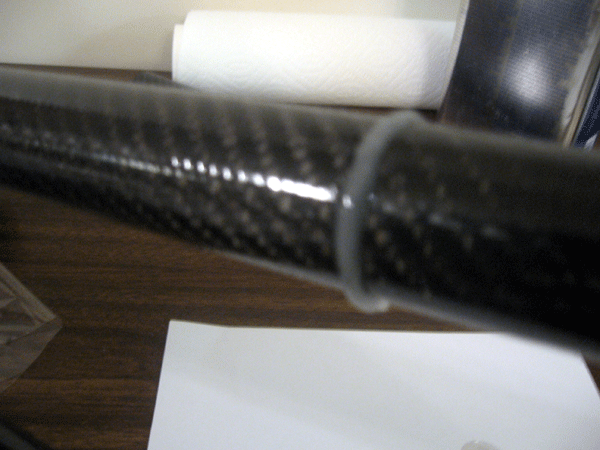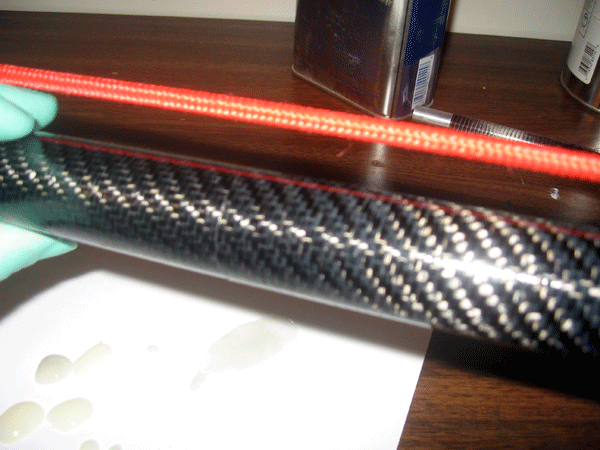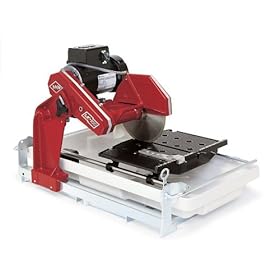
When a customer buys our tubing we want them to be able to start utilizing it right away. One large difference between us and our competition is that we make it easy for you to learn the basics of cutting and bonding even before you buy from us. We realize that a little customer service can take us far with our customers. This is why we published our cut and bond page. We plan plan on contributing to this page on a regular basis to give you the inside scoop on working with this specialized material. SIMPLE CUT AND BOND GUIDE -DISCLAIMER- STEP 1: The first decision you face when bonding tubes together is which adhesive to use. There are many variables that must be accounted for before you select an adhesive for your project. These may include but are not limited to the temperature range in a given application, chemical exposure if any, and weather exposure. For this test we have selected Loctite 9430 as shown in the image below. This is a room temp curing, two part epoxy designed for structural bonding. We chose this epoxy due to it's high peel and shear strength coupled with it's resistance to environmental factors. You can view the the technical document published by Loctite here. This epoxy is easy to use but has a cure time of about 5 days. You may also oven cure this epoxy for faster cure. Please read the entire technical document before moving forward. We suggest you print it out at this point so that you may refer back to it later on.
|
CUTTING FAQ How do I cut carbon fiber tubes? This is a common question and the answer will depend on what the type of cutting equipment you have access to and the amount of cutting you have. The tools required to cut carbon tubing could be as basic as a hacksaw or as extravagant as an industrial wet saw costing thousands of dollars. Before I get into the specifics of the task at hand let me remind you that Ultra Carbon Fiber (cfts) accepts no responsibility for injury or loss as a result of cutting carbon tubing. This FAQ is to be used as guide but you are solely responsible for the safe operation of any tools or equipment you decide to use. Working with power tools is dangerous and all possible safety measures should be taken to avoid personal injury. Now that we have that stuff out of the way let's move into he possible cutting options available. At the inexpensive end you can cut carbon tubing with a basic hacksaw. To cut tubing with a hacksaw I suggest wrapping the cut zone with a wrap or two of basic masking tape prior to cutting the tube. This will minimize fiber break out at the cut zone. In order to cut the tube you need to have a suitable way to hold the tube that is being cut. I would suggest a vice of the appropriate size for the tube and make sure the vice is equipped with rubber pads or some other padding to make sure you don't hurt the tube surface. Use very light clamping loads or you may delaminate a layer inside the tube. Use only enough pressure to hold the tube. Our stock tubes are designed to resist bending loads and not crushing loads. Although we can custom build custom tubes that will resist such loads you need to take great care when clamping our stock tubes. The relative strength and stiffness of a given tube depends mainly on fiber orientation so be careful. Once the tube is tape wrapped and clamped in place you can begin to saw the tube. Since you are using a hacksaw it would be a wise idea to cut the tube about 1/16" long and then sand back to your needed length. Saw in long smooth strokes and let the tool do the work. Carbon is very abrasive so don't expect a hacksaw to last more than a few cuts before it starts to dull. Use a hacksaw with very fine teeth like what you might use for cutting plastic or if you can find an abrasive only blade with no teeth that would be even better. Here is an example of a hacksaw blade with a carbide grit cutting edge: http://www.mytoolstore.com/starrett/hack03.html I would not suggest a hacksaw for any type of production cutting but it would work for a few cuts. If you have an uneven cut you can block sand it square with 100-150 grit sand paper. The second method for cutting tubing is similar to the first but instead of a hacksaw you can use a Dremel and a 7/8" diameter diamond coated cutting wheel. Here is a link to the cut off wheel as seen at Amazon: Dremel Wheel You can also purchase these wheels at your local hardware store Home Depot, Lowes etc but make sure you buy a Dremel brand wheel. Having tried knock off's from Harbor Freight and other sources they just don't math with the quality of a Dremel brand wheel. They aren't cheap at $15 but they make very precise cuts. The industrial diamond coating makes fast work of carbon and they last quite a long time. The main difference in cutting with a Dremel wheel and a hacksaw is one is powered and one is not. Since a Dremel spins at 15-30K rpm you will certainly need some safety glasses and a painters dust mask isn't a bad idea. A Dremel will kick off a lot of fine carbon dust which will cover everything around so keep that in mind when choosing a place to cut. You might also decide to have a helper hold a shop vac within about 5-6" of the tool to pull the dust while you make the cut. The dust is not toxic but the fine particles can get in your lungs so take the same precautions you would take when cutting wood for instance. The other downside to using a Dremel is that you can't make a square cut holding a tool free hand but you can black sand the cut end to square it up. Cutting the tubing at this rpm without a cooling medium (dry) not only kicks up dust but it heats up the resin in the matrix which will weaken the resin locally at the cut zone. In some applications this weakening may cause a structural issue but that will be left to your discretion. The third method of cutting carbon tubing is with a wet tile saw or any other saw that uses a cooling medium such as water and allows the use of a non toothed blade. The price of a tile saw starts at about $80 and goes above $5,000 depending on the brand, size of tubing you need to cut, and the options the saw includes. Starting at the low end you could buy a saw such as this tile saw from HF
Your local HF probably carries something similar to the saw above. Saws such as this are limited in the outer diameter that they can cut usually to about an inch OD so if you are using larger tubes you will need a different saw. A word of caution about this saw is you will need to remove the blade that is included with the saw and throw it away promptly. The diamond coated blade has rather large grit sizing and tends to splinter the cut and tear up the edge of the cut zone so it isn't really ideal for cutting carbon. If you were to think of the grit sizing like sand paper it would be somewhere around 60 grit which is way to low. The most important part of the equation here is the quality and specification of the blade so you will need to source it somewhere else. If you can't find one you can have one custom made by UKAM They are specialists in diamond blades and will build you a custom blade for $80-$100. I would suggest calling them 3 weeks before you need the blade. When you call them tell them you are cutting carbon epoxy laminate and be sure to tell them which arbor your saw has. Ironically the blade cost more than the saw itself but it will yield good results for low to medium volume cutting of sections 6-7" long or less. The main downside to this setup is that it can be difficult to set up the cutting fence accurately and the push block is hard to keep aligned with the fence but with practice you can net good results on a relatively low budget. Again placing one layer of masking tape at the cut zone will only improve the cut quality but it is a time consuming. It's amazing the difference a little tape can make. The upside of cutting with water is that the dust is not an issue at all so you don't need to cover the shop in plastic before cutting and it cools the cut zone so it really is the best way to go. For higher production cutting I would suggest an MK saw as shown:
This wet saw is a real gem because you can hold the stock against the fence and the slide the entire table top through the cut so it makes very precise cuts and is capable of doing it for hours on end. It can cut tubing over 3" in diameter so that is another plus. We have one of these saws in our shop and use it quite often. I would suggest buying a new blade from UKAM but the blade that is included isn't that bad so you could get by with the stock blade. You would probably be into the setup about $1,000 with shipping and a new blade but it is good value for the money and they are made right here in the USA. Beyond this level the saw increase in size and accuracy but unless you are running your saw 24/7 you probably don't need anything more than an MK. UKAM offers higher end saws and I'm sure they would be happy to quote you pricing if you need something larger than the MK. To finish off the cutting FAQ I thought I would specifically address a few issues that people ask about most often. I am often asked, can I cut your tubing with a metal chop saw or even a miter saw. The answer is yes but I wouldn't recommend it. A chop saw really heats up the cut zone and throws off a lot of dust. Besides being a pain to deal with carbon dust can get into electric motors and short them out since carbon is conductive. With a water cooled saw the dust is no longer a problem. If you don't want to invest in using the proper equipment we would be happy to handle your cutting no matter if you need one cut or 1000 cuts. For the fist cut we charge $5 and the second cut is $1.50 up to 10 cuts. Once you get beyond 10 cuts we will custom quote the cutting on a per job basis. We routinely have cutting jobs of several hundred cuts so we can often cut and ship within a day. I hope that this cutting information gives you some helpful insight into another aspect of working with our product. |
Copyright 2024 Carbon Fiber Tube Shop


